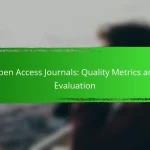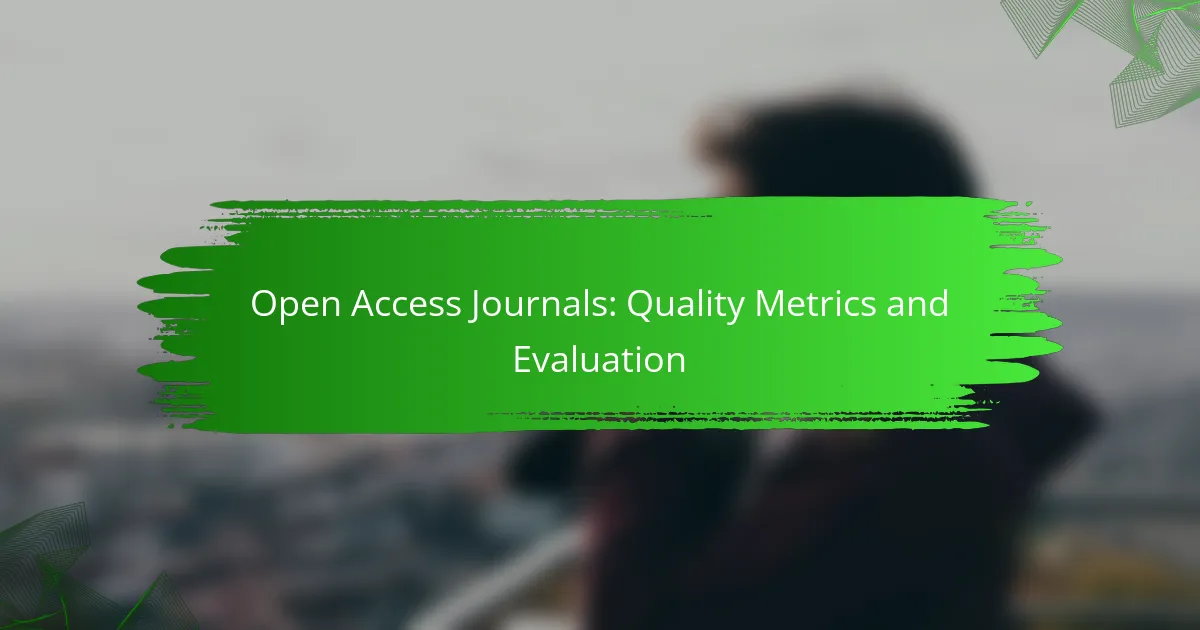Open Access Journals play a crucial role in the dissemination of research by providing unrestricted access to scholarly articles. Evaluating their quality involves examining key metrics such as impact, editorial integrity, and inclusion in recognized directories, which are vital for researchers and institutions in making informed publishing decisions. By ensuring high standards, these journals contribute significantly to the academic community and enhance the visibility of research findings.

What are the quality metrics for Open Access Journals in the UK?
The quality metrics for Open Access Journals in the UK include several key indicators that help assess their credibility and impact. These metrics are essential for researchers and institutions when choosing where to publish or access scholarly work.
Impact Factor
The Impact Factor is a commonly used metric that measures the average number of citations to articles published in a journal. For Open Access Journals in the UK, a higher Impact Factor often indicates greater influence and visibility within the academic community. Generally, journals with an Impact Factor above 1.0 are considered reputable.
However, it is important to note that the Impact Factor can vary significantly across disciplines, so comparing journals within the same field provides a more accurate assessment.
Scopus Indexing
Scopus indexing is another critical quality metric, as it signifies that a journal is included in one of the largest abstract and citation databases for peer-reviewed literature. Journals indexed in Scopus are often regarded as having met rigorous quality standards. Researchers should prioritize journals that are indexed in Scopus when seeking credible publication venues.
Being indexed in Scopus can enhance a journal’s visibility and accessibility, making it easier for researchers to find and cite relevant articles.
Peer Review Process
A robust peer review process is fundamental to ensuring the quality and integrity of published research. Open Access Journals in the UK should have a transparent and rigorous peer review system, typically involving multiple experts in the field reviewing submissions before publication. This process helps maintain high academic standards.
Researchers should inquire about the peer review policies of a journal, including the average time taken for reviews and the criteria used for acceptance, to gauge the journal’s commitment to quality.
Article Processing Charges
Article Processing Charges (APCs) are fees that authors may need to pay to publish their work in Open Access Journals. In the UK, these charges can range from a few hundred to several thousand British pounds, depending on the journal’s reputation and services offered. Understanding the APC structure is crucial for authors, especially those with limited funding.
Some journals offer waivers or discounts for authors from developing countries or for those who cannot afford the fees, so it is advisable to check the journal’s policy on APCs before submission.
Publication Frequency
Publication frequency refers to how often a journal releases new issues, which can impact the timeliness of research dissemination. Open Access Journals in the UK may publish monthly, quarterly, or biannually. A higher publication frequency can indicate a more active journal, potentially leading to quicker visibility for published research.
Authors should consider the publication frequency when selecting a journal, as it can affect how soon their work will reach the audience and contribute to ongoing discussions in their field.

How to evaluate Open Access Journals effectively?
To evaluate Open Access Journals effectively, consider their impact, editorial integrity, and inclusion in recognized directories. This ensures that the journals you choose maintain high standards and contribute meaningfully to the academic community.
Use Journal Citation Reports
Journal Citation Reports (JCR) provide metrics such as the Journal Impact Factor, which indicates the average number of citations to recent articles published in a journal. A higher impact factor often suggests a more influential journal. However, it’s essential to consider the field of study, as citation practices can vary significantly across disciplines.
When using JCR, look for journals with consistent citation patterns over several years rather than one-off spikes. This can help you gauge the journal’s stability and reputation within its academic niche.
Assess Editorial Board Credentials
The credentials of a journal’s editorial board are crucial indicators of its quality. A reputable board typically comprises recognized experts in the field, which enhances the journal’s credibility. Check the board members’ affiliations and their publication records to ensure they have substantial experience and expertise.
Be wary of journals with vague or incomplete information about their editorial board. Transparency is key; a well-established journal will openly list its board members and their qualifications.
Check for DOAJ Inclusion
The Directory of Open Access Journals (DOAJ) is a widely recognized index that lists high-quality, peer-reviewed Open Access journals. Inclusion in the DOAJ signifies that a journal meets specific quality criteria, including rigorous peer review and editorial policies. This can serve as a quick reference for assessing journal quality.
To confirm a journal’s DOAJ status, visit the DOAJ website and search for the journal title. If it’s listed, you can be more confident in its academic integrity. Journals not included in DOAJ may not adhere to the same standards, so proceed with caution when considering them for publication or research.

What are the benefits of publishing in Open Access Journals?
Publishing in Open Access Journals offers significant advantages, including enhanced visibility and accessibility of research findings. These journals allow anyone to read and share articles without subscription barriers, promoting wider dissemination of knowledge.
Increased Visibility
Open Access Journals provide increased visibility for authors, as their work is accessible to a global audience without paywalls. This can lead to higher citation rates and greater recognition within the academic community.
By publishing in these journals, researchers can ensure that their findings are easily discoverable through search engines and academic databases, which often prioritize Open Access content. This visibility can be crucial for career advancement and collaboration opportunities.
Broader Audience Reach
Open Access Journals reach a broader audience, including researchers, practitioners, and the general public. This inclusivity allows for diverse engagement with the research, potentially influencing policy and practice beyond academia.
For example, a public health study published in an Open Access Journal can be accessed by healthcare professionals and policymakers, facilitating informed decision-making. This wider reach can amplify the impact of research findings significantly.
Faster Publication Times
Open Access Journals often have faster publication times compared to traditional subscription-based journals. This speed is beneficial for researchers eager to share their findings promptly with the community.
Many Open Access Journals utilize streamlined peer review processes and digital platforms, which can reduce the time from submission to publication to just a few months. This efficiency is particularly advantageous in fast-moving fields such as technology and medicine.

What challenges do Open Access Journals face?
Open Access Journals encounter several significant challenges, including maintaining quality control, securing funding for sustainability, and combating the rise of predatory journals. These issues can impact their credibility and long-term viability in the academic publishing landscape.
Quality Control Issues
Quality control is a critical concern for Open Access Journals, as they must ensure that published research meets rigorous academic standards. This often involves implementing robust peer review processes, which can be resource-intensive and time-consuming.
Many journals struggle to attract qualified reviewers, leading to potential delays in publication and varying standards of quality. Journals should establish clear guidelines and utilize technology to streamline the review process while maintaining integrity.
Funding and Sustainability
Funding is a major challenge for Open Access Journals, as they typically rely on article processing charges (APCs) or institutional support. The costs associated with publishing, including editorial management and hosting, can be substantial.
To ensure sustainability, journals should explore diverse funding models, such as grants, sponsorships, or membership fees. Engaging with academic institutions and fostering partnerships can also provide financial stability.
Predatory Journals
Predatory journals pose a significant threat to the reputation of legitimate Open Access Journals by exploiting the model for profit without providing proper editorial services. These journals often lack transparency and do not adhere to established publishing standards.
Researchers should be cautious when selecting journals for publication. They can avoid predatory journals by checking for membership in reputable organizations, verifying editorial board credentials, and reviewing the journal’s publication history. Utilizing resources like the Directory of Open Access Journals (DOAJ) can also help in identifying credible options.

What are the trends in Open Access publishing in the UK?
Open Access publishing in the UK is increasingly characterized by greater institutional support, innovative funding models, and enhanced collaboration with libraries. These trends reflect a commitment to improving access to research while ensuring quality and sustainability.
Growing Institutional Support
Many UK universities are now actively promoting Open Access publishing as part of their research strategies. This support often includes funding for article processing charges (APCs) and establishing dedicated Open Access policies to encourage researchers to publish in accessible formats.
Institutions are also investing in infrastructure to facilitate Open Access, such as repositories and platforms that host research outputs. This trend helps to ensure that publicly funded research is freely available to the public, aligning with the UK government’s commitment to transparency in research dissemination.
Emergence of New Models
The landscape of Open Access publishing is evolving with the introduction of various funding models, such as diamond and platinum Open Access, which do not charge authors any fees. These models are gaining traction as they allow for free access to research without the financial burden on authors or institutions.
Additionally, hybrid models that combine subscription and Open Access elements are becoming more common. These models offer flexibility but can also lead to confusion regarding access rights and costs, making it essential for researchers to understand the implications of their publishing choices.
Increased Collaboration with Libraries
Libraries in the UK are playing a pivotal role in the Open Access movement by providing resources and support for researchers navigating the publishing landscape. They often offer guidance on compliance with Open Access mandates and assist in managing APCs.
Furthermore, collaborations between libraries and publishers are fostering the development of new platforms and tools that streamline the publishing process. This partnership enhances the visibility of research outputs and ensures that they reach a broader audience, ultimately benefiting the academic community and the public alike.

How does Open Access impact academic research in the UK?
Open Access significantly enhances academic research in the UK by increasing the visibility and accessibility of scholarly work. This model allows researchers to share their findings freely, fostering greater collaboration and knowledge dissemination across disciplines.
Enhanced Research Collaboration
Open Access promotes enhanced research collaboration by breaking down paywall barriers that often restrict access to academic publications. Researchers from various institutions, including those with limited funding, can access and contribute to a wider pool of knowledge.
This increased accessibility encourages interdisciplinary partnerships, as scholars can easily find and utilize relevant studies from other fields. For instance, a biologist can access articles from social sciences to explore the societal impacts of their research, leading to more comprehensive studies.
To maximize collaboration, researchers should actively share their work in Open Access platforms and engage with other scholars through online forums and networks. This approach not only broadens their research impact but also fosters a community of shared knowledge and innovation.






